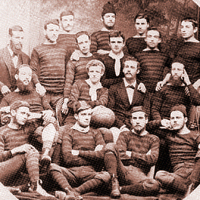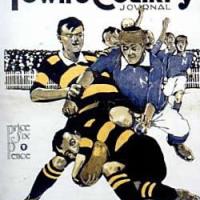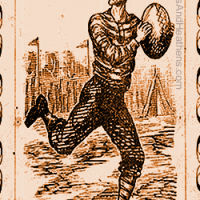The Wallabies made their debut 18 months before the nation of Australia was born – yet the original ambition in 1899 was not for an Australian team, but the combined might of ‘Australasia’ instead.

The NSWRU planned for a Test series to be played in Sydney between ‘Australasia’ and the touring Great Britain side.
Given the four Home Nations had combined to send a team out, it was said at the time that it was only logical that they be tested in battle by the collective resources of Australasia’s three rugby-playing colonies (NSW, Queensland and New Zealand).
In 1899 there was still a strong possibility that New Zealand would join with the other colonies in forming the new Federated nation and parliament. Indeed, as many would be aware, the Constitution of Australia (written in 1900) includes provision for New Zealand as a member state.
In the early 1900s ‘Australasia’ teams competed in the Olympic Games, Davis Cup tennis and rugby league. The Roar columnist Spiro Zavos put forward the proposition that the 1908 Olympic gold medal won by the Wallabies in rugby could be equally claimed by New Zealand, as the team was officially entered as ‘Australasia’.
There was widespread public and newspaper support and agreement in 1899 for an ‘Australasian’ rugby team to be formed to meet the Lions. Many argued that putting Queenslanders into a NSW team to create a combined ‘Australia’ merely served to produce a weaker NSW team taking the field under another name. Adding New Zealanders would have the opposite effect.
Keen to ensure the popular ‘Australasia’ team came to reality, the NSWRU put separately to the QRU and NZRU “that her best players should come over here at the expense of the NSWRU to take part.”
Unfortunately (or perhaps fortunately depending on your view) what should have been a straight forward offer readily accepted, and perhaps the beginning of what would now be a century old tradition, got caught up in negotiations over other matches and lost.
As the hosts of the British team, the NSWRU controlled all match and tour arrangements, and were responsible for all expenses. If the QRU and NZRU hoped to hold matches against the Lions, they would have to negotiate financial terms and secure available dates with the NSWRU.
The NSWRU recognised that the longer the visitors were away from Sydney in Brisbane or Auckland, the less the Union’s overall income would be, and more vulnerable it would be if any of the remaining games’ attendances were affected by wet weather. The terms it sought with the other colonial Unions required that it be compensated for the lost income.
A short visit to Brisbane was readily agreed to with the QRU, however the more remote New Zealanders (five-days sailing from Sydney) found negotiations with the NSWRU far more demanding.
The NZRU sought to host a two-match visit. The NSWRU reasoned that by giving up two (at least) Sydney matches to allow the Lions to visit New Zealand, it would miss out on a further £1,200. The NSWRU advised the NZRU they would consent to the visit if they guaranteed £400, covered all accommodation costs and paid for the team’s return trip to and from Sydney.
The NZRU, who had nothing like the financial resources of the NSWRU, and no city the size of Sydney from which to draw comparable attendances and gates, could only offer a share from the matches in New Zealand. No agreement was reached, and the British visit to New Zealand was abandoned.
The New Zealand rugby community and public were incensed, with many wondering what the point of affiliation with other Unions was if decisions were to be made solely on financial grounds.
Seemingly oblivious to the offence it was causing across the Tasman, the NSWRU then put forward the idea that Sydney host a New Zealand vs Britain match at the SCG and split the gate with the NZRU.
Infuriated at their treatment, the New Zealanders decided not to send any players to Sydney for the Australasia team.
The Sydney newspapers expressed disappointment at the NZRU’s decision, stating that an international match between the combined colonies and the Lions “with New Zealand unrepresented is absurd from a purely football point of view.” The Sydney Morning Herald added that “this means the matches will be ‘Australia’ instead of ‘Australasia’ and that the team will only consist of NSW and Queensland players.”
The fall-out from the NSWRU’s treatment of the NZRU was the collapse of significant work and efforts that were in train to form an ‘Australasian Rugby Football Union,’ which was being pushed particularly strongly within New Zealand rugby.
Many on both sides of the Tasman believed rugby ought to be made more safe to play, attractive to watch, and make some concessions in regard to payments to players.
It was thought the formation of a combined Australasian Union, representing all the colonies, would have a far greater voice with the RFU in England and the International Rugby Board.
Failing that, an Australasian Union could standardise playing rules across the colonies, and, if it came to it, break away from the Unions in Britain, and follow a path to a new rugby code (akin to the evolution that was already well under way to what was once rugby in Canada and the USA).
However, as with the political movement to form a national Federation of all the colonies, the New Zealanders went their own way – the colony did not become part of the new nation, and rugby never got its Australasian Rugby Union (the Australian Rugby Union was founded in 1949).
It would be a gross over-stating of the situation to lay at the feet of the NSWRU the reason New Zealand did not join with the other colonies in the new Federation, but then, as now, rugby was dear to the heart of most New Zealanders. At the very least, the actions of the NSWRU didn’t help those in New Zealand advocating for the colony to be part of the Federation.
Immediately that the NZRU announced the Lions would not be touring, and that no players would be sent to join the ‘Australasia’ team, more than a dozen New Zealand footballers jumped on to steam-ships and hooked-up with Sydney rugby clubs.
Australian rugby had no residential rules – and the New Zealanders knew it. Once they took to the field, they qualified as Australians, and played in the hope of being selected for the Test team.
By the time Australia’s team for the fourth Test was chosen, with the home side desperate to square the series with a victory, the selectors had no qualms in choosing four New Zealanders, including 1897 representative Bill Hardcastle. In a manner of speaking, the NSWRU finally got its Australasia team.
In the aftermath the NZRU negotiated directly with the RFU to send a New Zealand team to Britain without any involvement of the Australian unions. That team and tour eventually came to reality in 1905, and became the famous “All Blacks”.
Their success ensured no one again put forward the idea of Australia and New Zealand rugby combining as ‘Australasia’ to play the Lions or mounting a tour of Britain.
For that, the Northern Hemisphere rugby nations are probably eternally thankful – a combined Wallabies-All Blacks touring team is not something they need to contemplate.
© Sean Fagan










